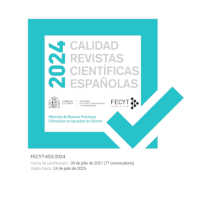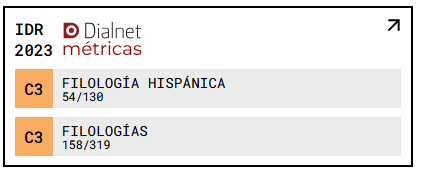La fiction dystopique en anglais: analyse de l’estime guidée pour le corpus de la trilogie «Divergente», de Veronica Roth
DOI :
https://doi.org/10.18172/cif.4475Mots-clés :
Dystopie, adolescents, Divergente, estime de soi, estime, annotationRésumé
Compte tenu de la popularité récente de la fiction dystopique pour adolescents et en particulier de la trilogie Divergente, de Veronica Roth, les chercheurs ont commencé à s’intéresser sur ce sous-genre. Actuellement la recherche tend à se concentrer sur les approches de genre et éducatives sans prendre en compter en général les aspects psychologiques des personnages. Mon article se concentre en la représentation de l’estime et de l’estime de soi à travers d’une analyse basée sur l’annotation. Les résultats offrent des informations sur les facteurs qui affectent le rôle et l’estime de soi de la protagoniste.Téléchargements
Références
AMES, M. (2013). “Engaging “apolitical” adolescents: Analyzing the popularity and educational potential of dystopian literature post-9/11”. The High School Journal 97: (1): 3-20. DOI: https://doi.org/10.1353/hsj.2013.0023
AMES, M. (2018). “Responsibility in the composition classroom” in Young Adult Literature in the Composition Classroom: Essays on Practical Application. (Eds. T. Girardi and G. Scheg). Jefferson: McFarland: 21-29.
BALL, R. (2016). Actors and aliens: Representations of Teenage Protagonists in Bestselling YA Fiction. Victoria University of Wellington (Doctoral thesis). <https://researcharchive.vuw.ac.nz/xmlui/bitstream/handle/10063/6127/thesis.pdf?sequence=1>.
BASU, B., BROAD, K. R. y HINTZ, C. (Eds.) (2014). Contemporary Dystopian Fiction for Young Adults: Brave New Teenagers. New York: Routledge. DOI: https://doi.org/10.4324/9780203084939
CAMPANELLA, T. (2009). The City of the Sun. SMK Books. Publicado originalmente (1602).
COLLINS, S. (2008). The Hunger Games. New York: Scholastic.
COLLINS, S. (2009). Catching Fire. New York: Scholastic.
COLLINS, S. (2010). Mockingjay. New York: Scholastic.
DAY, S. K., GREEN-BARTEET, M. A. and MONTZ, A. L. (Eds.), (2014). Female Rebellion in Young Adult Dystopian Fiction. Farnham: Ashgate Publishing, Ltd.
HARRIS, M. A., GRUENENFELDER-STEIGER, A. E., FERRER, E., DONNELLAN, M. B., ALLEMAND, M., FEND, H., CONGER, R. D. y TRZESNIEWSKI, K. H. (2015). Do Parents Foster Self-Esteem? Testing the Prospective Impact of Parent Closeness on Adolescent Self-Esteem. Child Development 86 (4): 995-1013. https://doi.org/10.1111/cdev.12356. DOI: https://doi.org/10.1111/cdev.12356
HINTZ, C. y OSTRY, E. (Eds.). (2003). Utopian and Dystopian Writing for Children and Young Adults. London: Routledge.
HOOVER, D. L., CULPEPER, J. and O’HALLORAN, K. (2014). Digital Literary Studies: Corpus Approaches to Poetry, Prose, and Drama (Vol. 16). London: Routledge. DOI: https://doi.org/10.4324/9780203698914
JARVIS, C. (2015). “How to be a woman: Models of masochism and sacrifice in young adult fiction” in Popular Culture as Pedagogy: Research in the Field of Adult Education. (Eds. K. Jubas, N. Taber y T. Brown). Rotterdam: Sense Publishers: 134-150.
JERKOVIĆ, S. V. and ALIHODŽIĆ, D. (2018). The Hunger Games in Bosnian-Herzegovinian context: the study of the effects of young adult dystopian literature on high-school students. Društvene i Humanističke Studije 1 (4): 223-238.
KENNY, U., SULLIVAN, L., CALLAGHAN, M., MOLCHO, M. and KELLY, C. (2018). “The relationship between cyberbullying and friendship dynamics on adolescent body dissatisfaction: a cross-sectional study.” Journal of health psychology 23 (4): 629-639. DOI: https://doi.org/10.1177/1359105316684939
KOUTSOULELOU, S. (2017). “Crisis is written all over me. Greece in Crisis: Combining critical discourse and corpus linguistics perspectives” in Greece in Crisis: Combining critical discourse and corpus linguistics perspectives. (Eds. O. Hatzidaki and D. Goutsos). Philadelphia: John Benjamins Publishing Company: 263-289. DOI: https://doi.org/10.1075/dapsac.70.08sta
LOMAS, T. (2017). “Can Mindfulness help at-risk adolescent boys?” En Making a Difference with Psychology. (Eds. K. Niven, S. Lewis and C. Kagan). Manchester: Richard Benjamin Trust: 113-120.
LOWRY, L. (1993). The Giver Quartet Omnibus. En L. Lowry (2014), The Giver Quartet Omnibus. Boston: HMH Books for Young Readers.
MARSHALL, M. (2014). What Mainstream Centers Cannot Hold: Growing Critical Literacy with Dystopian Fiction in Teaching towards Democracy with Postmodern and Popular Culture Texts. (Eds. P. Paugh, T. Kress and R. Lake). Rotterdam: Brill Sense: 135-150. DOI: https://doi.org/10.1007/978-94-6209-875-6_9
MORE, T. 2010 (1516). “Libellus vere aureus, nec minus salutaris quam festivus, de optimo reipublicae statu, deque nova insula Vtopiae” in Utopia. (Ed. L. Winkler). Scotts Valley, CA.: CreateSpace Independent Publishing Platform.
NARR, R. K., ALLEN, J. P., TAN, J. S. and LOEB, E. L. (2017). “Close friendship strength and broader peer group desirability as differential predictors of adult mental health.” Child development 90 (1): 298-313. https://doi.org/10.1111/cdev.12905. DOI: https://doi.org/10.1111/cdev.12905
PARENT, M. C., GOBBLE, T. D. and ROCHLEN, A. (2018). Social media behavior, toxic masculinity, and depression. Psychology of Men & Masculinity. Advance online publication. http://doi.org/10.1037/men0000156. DOI: https://doi.org/10.1037/men0000156
PATAKI, J. (2017). “To read and learn: The necessity for a new definition of dystopia and bridging the gap between the old and contemporary dystopias” [Reseña del libro The Boundaries of Dystopian Literature. The Genre in Context, escrito por D. Alihodžić and S. Veseljević Jerković]. Anafora-časopis za znanost o književnosti 4 (2): 426-430. DOI: https://doi.org/10.29162/ANAFORA.v4i2.16
PIOTROWSKI, A. and RYBAKOVA, K. (2015). “Reading adolescents in dystopian YAL through the lens of feminism.” GALA Journal: A Journal of the Gender in Literacy and Life Assembly 21: 23-30.
SAUNDERS, J. M. (2014). “What The Hunger Games can teach us about disciplinary literacy.” English Journal 103 (3): 41-47.
SIMMONS, A. M. (2014). “Class on fire: Using the Hunger Games trilogy to encourage social action” in Teaching towards Democracy with Postmodern and Popular Culture Texts (Eds. P. Paugh, T. Kress and R. Lake). Rotterdam: Brill Sense: 77-95. DOI: https://doi.org/10.1007/978-94-6209-875-6_6
SOARES, M. A. (2018). “Here’s looking at you kids: The urgency of dystopian texts in the secondary classroom” in Worlds Gone Awry: Essays on Dystopian Fiction (Eds. J. J. Han, C. C. Triplett and A. G. Anthony). Jefferson: McFarland: 210-224.
SUJOLDŽIĆ, A. and DE LUCIA, A. (2007). “A cross-cultural study of adolescents-BMI, body image and psychological well-being.” Collegium Antropologicum 31 (1): 123-130.
SWIFT, J. (1723). Travels into several Remote Nations of the World. In Four Parts. En (2009) Gulliver’s Travels. Reading: Oneworld Classics.
TORSHEIM, T. and WOLD, B. (2001). “School-related stress, support, and subjective health complaints among early adolescents: A multilevel approach.” Journal of adolescence 24 (6): 701-713. DOI: https://doi.org/10.1006/jado.2001.0440
TRITES, R. S. (2000). Disturbing the Universe Power and Repression in Adolescent Literature. Iowa City, IA: University of Iowa Press.
VAN MELCKEBEKE, S. (2018). Young Adult Dystopian Literature. Didactic Benefits of its use in the English Subject Classroom in Norway (Master’s thesis). Inland Norway University of Applied Sciences.
WESTERFELD, S. (2005). Uglies. New York: Simon Pulse.
WESTERFELD, S. (2005). Pretties. New York: Simon Pulse.
WESTERFELD, S. (2006). Specials. New York: Simon Pulse.
WILKINSON, R. B. (2010). “Best friend attachment versus peer attachment in the prediction of adolescent psychological adjustment.” Journal of Adolescence 33 (5): 709-717. DOI: https://doi.org/10.1016/j.adolescence.2009.10.013
Téléchargements
Publié-e
Comment citer
Numéro
Rubrique
Licence
Les articles appartiennent à leurs auteurs respectifs qui accordent à la revue le droit de première publication, l’autorisation de la revue n’étant pas nécessaire pour leur diffusion une fois publiés. Une fois la version de l’éditeur publiée, l’auteur est tenu de s’y référer dans les versions archivées dans les dépôts personnels ou institutionnels.
Il est conseillé aux auteurs/s d’archiver la version de l’éditeur dans des dépôts institutionnels.
La revue permettant à d'autres de réutiliser les ouvrages selon les conditions de la licence CC Attribution 4.0 International (CC BY 4.0)














